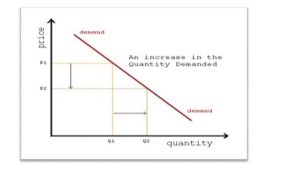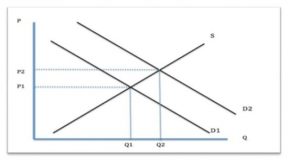Microeconomics
| MULTIPLE CHOICE ANSWERS | ||||||||||
| NO | 1 | 2 | 3 | 4 | 5 | 6 | 7 | 8 | 9 | 10 |
| Answer | D | C | C | B | D | C | A | B | C | A |
2.1 Distinguish between an increase in demand and an increase in quantity demanded
As per economic rules, the quananded dentity demotes a specific amount on the provided price which shows the whole the relationship among the different quantities demanded on different prices (Boyes and Melvin, 2013). In order to quantity demanded, the changes in the prices conduct the changes in the quantity demanded. Certain points in the demand curve are referred typically. Moreover, the movement in the demanded curve is represented by the change in the quantity demanded. The below mentioned graph is represents that how the quantity demanded is increased by the decrease in the prices.

[Source: Boyes and Melvin, 2013]
At the same time, relationship between quantities demanded and prices show the kind of demand (Besanko and Braeutigam, 2010). The demand of the service and goods are leaded by the changes in the factors apart from price of the service and goods. Because of these changes the quantities demanded is not same. Normally, an increase in the customer willingness to buy the specific product and service can be described as a increase in the demand.
Although, Different factors are found that are responsible for increasing in the demand but it cannot be denied that the price is the important factor. The below mentioned graph describes the reason of the increase in the demand for quantity due to the decline in the price.

[Sources: Besanko and Braeutigam, 2010]
2.2 Demand or supply in the following situations.
- In the case of improving the situation of Australian economy, it is confirmed that Different huge overseas Australian companies will determine to perform in the super market business in Australia. Due to above situation, the retail market competition will be increased and the customers will be able to buy products at lowest prices (Gratton-Lavoie and Stanley, 2009). As per this condition, the products supply will be increased so the customers can be purchased the products easily and this situation will lead for decreasing in the demand.
- In context to this situation, it can be as described as that the market demand will be affected when it is decided by the consumers immediately that tattoos are not in current trend in the market. This is happened due to demand of fashion that always remains high in this condition. Thus, the decrease in the demand will be leaded by the customers. In the different view, it can possible that the supply will be increased.
- In order to this condition, it is determined by the department of employment of Australia that the job prospects of young people are increased by the playing computer games. This situation will be helpful to improve the rate of employment and it will also helpful to increase the power of customers towards expenditure (Hall and Lieberman, 2009). It is well known that if the customer’s expenditure power increases, then the supply or demand also increase.
- As per the situation of damage the coffee crop, consumers will be expected that the price of coffee will also be increased simultaneously. This situation will encourage the customers to sell or buy the coffee in the market and this result will to increase the demand of products.
- In order to this situation, when the prices are increased by the supplier, then the consumers try to find the alternate of those products to fulfill their needs. As per this situation, it can also possible that consumer will find competitor product.
- In context to this condition, when the price of the complementary products are increased then the core product’s prices increase simultaneously. The price of the cold drink market will be increased, when the price of reticulated water increases.
- The removal of excise tax on the cigarettes will reduce the price of cigarettes due to decline in cost of production (Moon, 2013). It will create high demand of this product in the market. But if the government does not remove this tax then the demand of cigarettes will be constant.
- Price of new product is significant to create demand for this product. So, price of robot will be crucial in influencing the robot market. In addition, substitute price and complementary product price will be significant in this case. Apart from this, income level also decides the demand of such product.
Price elasticity of demand
In the price elasticity of the demand represents the % change in the demand of the product demand due change in the price of the product. Price elasticity of demand is one of the main concepts in the economic study. In order to measure the relationship between the price and demand, the below formula is used:
Price elasticity of demand = % change in price of the product / % change in the demand of the product (Mankiw, 2014)
Income elasticity of demand
Income based elasticity is based on the change in the income level of the customers. Generally, it can be seen that change in the income level of the customer affect the market demand of the product. In the other words, income elasticity of demand is a term that determines the affect the change in the income on the demand of the product. For Income elasticity of demand, the below formula is used:
Income elasticity of demand = % change in the income of the customer / % change in the demand of the product (Hubbard et al., 2015)
Cross elasticity of demand
It is also a well known elasticity of demand in the microeconomics. Typically cross elasticity of demand measures the market demand of the product after the change in the price of the relative products (substitute and complementary). In order to measure the cross elasticity of demand, following formula is used:
Cross elasticity of demand = % change in the relative product price / % change in the core product demand (Blanchard et al., 2010)
2. Consider the following demand schedule.
a) Construct the cost schedule for a firm operating in the short run
2. Graph the average variable cost, average total cost and marginal cost curves

Besanko, D. and Braeutigam, R. (2010) Microeconomics. USA: John Wiley and Sons.
Blanchard, O., Dell’Ariccia, G., & Mauro, P. (2010). Rethinking macroeconomic policy. Journal of Money, Credit and Banking, 42(s1), 199-215.
Boyes, W., and Melvin, M. (2013) Fundamentals of economics. USA: Cengage Learning.
Gratton-Lavoie, C. and Stanley, D. (2009) Teaching and learning principles of Microeconomics online: An empirical assessment. The Journal of Economic Education, 40(1), pp.3-25.
Hall, R. E. and Lieberman, M.(2009) Microeconomics: Principles and Applications. Cengage Learning.
Hubbard, G., Garnett, A., Lewis, P., & O’Brien, T. (2015). Essentials of Economics 3rd ed. Melbourne: UK: Pearson.
Mankiw, N. G. (2014). Principles of macroeconomics. UK: Cengage Learning
McEachem, W. A. (2016) Microeconomics: A Contemporary Introduction. USA: Cengage Learning.
Moon, M.A. (2013) Demand and Supply Integration: The Key to World-Class Demand Forecasting. USA: FT Press.


